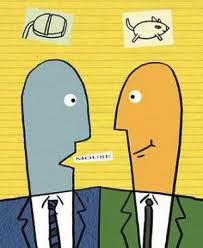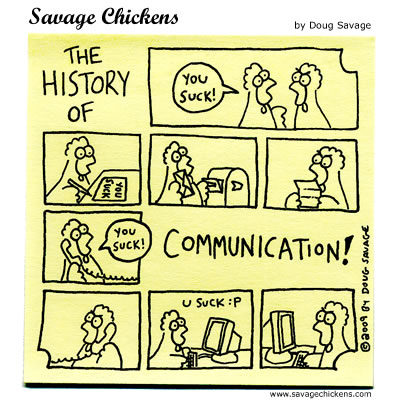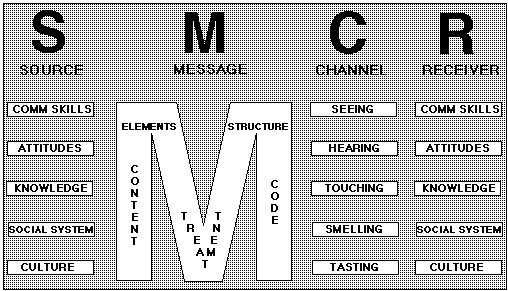Communications theory
The word communication means to share, impart or make common. It comes from the Latin
word communicaire. Communication is an active process that is continually changing and
evolving. How well we communicate is often determined by how easily we can share or
impart information or find common ground with other people.
word communicaire. Communication is an active process that is continually changing and
evolving. How well we communicate is often determined by how easily we can share or
impart information or find common ground with other people.
Language changes overtime and someone like Shakespeare may have difficulty understanding “textspeak”. Everytime we speak we put together a selection of words we may have never used before. 2 people communicating with each other may have no idea where they will end up in conversation.
What Reasons Do We Have to Communicate?
-Survival
-Co-operation
-Personal needs
-Relationships
-Persuasion
-Power
-Societal needs
-Economy (buying and selling)
-Information
-Making sense of the world
-Decision making
-Self-expression
Discuss in class examples of the reasons for communication as highlighted above. Can you give a real world example as to why any of the points above are reasons to communicate?
For Communication to be Effective:
-Effective communication is about conveying your message to others clearly and minimising
dangers for misinterpretation
dangers for misinterpretation
 |
| Example of how information can be misinterpreted |
-Effective communication is also about
receiving information from others, with
minimal distortion
receiving information from others, with
minimal distortion
What is the communication process?
The communication process is an important process by which humans communicate with each other.
There are THREE basic elements which are central to the communication process.
1. The audience
1. The audience

2. The Message you want to share
Communication Theory Definitions
Message: The information you want to communicate
Encoding: The process of transferring info you wish to communicate into a form that can be
sent and decoded at the other end. Encoding is is the process by which information from a
source is converted into symbols to be communicated
Channel: The method used to communicate eg face to face meetings, telephones & video
conferencing, letters, emails, memos, reports
Decoding: the process of transforming information from one format into another, usually
information sent from the sender.
Receiver: Must understand your message and is at the receiving end of the communication
channel. They receive decoded messages or info from the sender. Sometimes, the receiver
has to decode the message themselves
Encoding: The process of transferring info you wish to communicate into a form that can be
sent and decoded at the other end. Encoding is is the process by which information from a
source is converted into symbols to be communicated
Channel: The method used to communicate eg face to face meetings, telephones & video
conferencing, letters, emails, memos, reports
Decoding: the process of transforming information from one format into another, usually
information sent from the sender.
Receiver: Must understand your message and is at the receiving end of the communication
channel. They receive decoded messages or info from the sender. Sometimes, the receiver
has to decode the message themselves
 |
| Example of positive feedback |
Feedback: is the verbal and nonverbal reaction to a communicated message. Close attention to feedback can give the sender confidence that the message is understood. Feeding back part of the output so as to increase the input is positive feedback; feeding back part of the output in such a way as to partially oppose the input is negative feedback.
Context: the relevant constraints of the communicative situation that influence language use, language variation, and discourse. This may include the surrounding environment or broader culture (corporate culture, international culture). It can be the surroundings, circumstances, environment, background, or settings which determine, specify, or clarify the meaning of the message
|
|
| A famous still image of John McCain taken out of context in the last US election |
In order for the transfer of information to qualify as communication, the recipient must
understand the meaning of the information transferred to them. If the recipient does not
understand the meaning of the information conveyed to them, communication has not taken
place.
Shannon and Weaver's communication model
As you can see in the example below, Communicator A is sending a message to Communicator B through a medium (channel). The message is transferred through the medium and received by Communicator B. Communicator B decodes the message, understands the message and sends it back to Communicator A. Meaningful communication has taken place if the information exchanged occurs in a common manner of language that both Communicator A and B understands.
How the audience, message and channel elements factor into the communication process:
 | ||
| The Communication Process |
Lets say the person on the left in the diagram above wants to send a message to the person
the right.The man on the left has to decide what language the man on the right will need in
order to understand the message.Also the man on the left has to take into account societal
factors such as the relationship between them and the context of the message These 3
factors of language, relationship with each other as well as the context of the conversation
will influence the tone of their conversation. Next, the appropriate channel needs to be
selected to communicate the message. Typical channels of communication include:
Writing, face-to-face speaking, having a telephone conversation, video-call, email, fax, SMS
or even through instant online messaging providers such as Instant Messenger.The man on
the right may give feedback to the man on the left to further his understanding of the message
and having more clarity regarding the appropriate response.
the right.The man on the left has to decide what language the man on the right will need in
order to understand the message.Also the man on the left has to take into account societal
factors such as the relationship between them and the context of the message These 3
factors of language, relationship with each other as well as the context of the conversation
will influence the tone of their conversation. Next, the appropriate channel needs to be
selected to communicate the message. Typical channels of communication include:
Writing, face-to-face speaking, having a telephone conversation, video-call, email, fax, SMS
or even through instant online messaging providers such as Instant Messenger.The man on
the right may give feedback to the man on the left to further his understanding of the message
and having more clarity regarding the appropriate response.
Here is a video which uses the model of a message sent through a paper aeroplane to demonstrate the communication process:
Youtube Video
Communication Theory
https://www.youtube.com/watch?v=mQSL8aqTDLg
Uploaded by bluetommb on 4 Dec 2009
Youtube Video
Berlo's Communication Model
In 1960, David Berlo expanded on Shannon and Weaver's model of communication. It takes into account the emotional aspect of the message. Berlo's model of communication operates on the SMCR model
S=Source
M=Message
C=Context
R=Receiver
Here is a useful link which looks at Berlo's model in more detail
What effect is communication having on contemporary society?










No comments:
Post a Comment